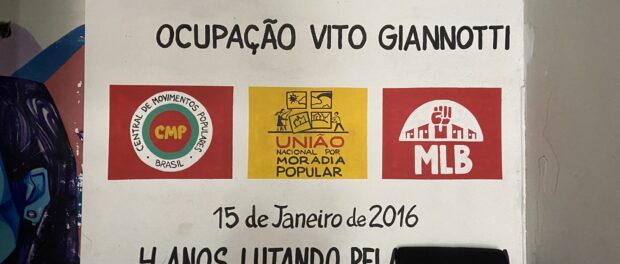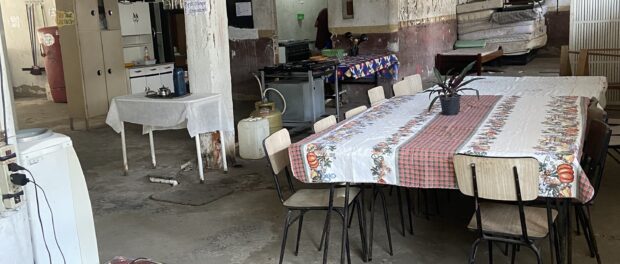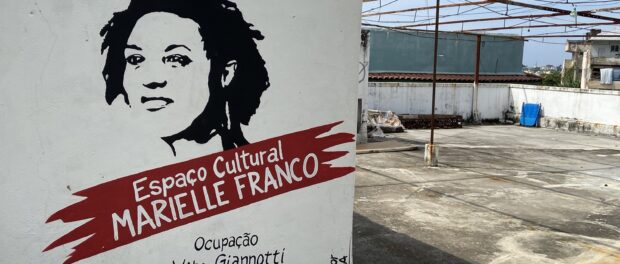
This is the first of two articles on the struggle of two projects for affordable housing in Rio de Janeiro’s Port Region, situated in the city’s downtown Centro. Despite being an area that was, for many decades, primarily occupied by low-income residents, the Port Region began to be coveted by real estate speculators after the Porto Maravilha urban renewal project began, and since then, the low-income population’s ability to remain in the region is constantly under threat. In this second article we delve into the experience of the Vito Giannotti occupation, in Santo Cristo, which has been fighting for five years over a building—which stood abandoned for 15 years—to be definitively allocated as housing for the 28 families that occupy it. For the first article, click here.
The Vito Giannotti occupation emerged in January 2016, with the objective of giving a social function to a building belonging to the National Social Security Institute—INSS, left abandoned for over 15 years. The building was originally a hotel, which makes its potential vocation as housing evident.
The occupation’s name is a tribute to community communicator Vito Giannotti, an icon of the struggle for people’s communication in Brazil, deceased in 2015. Curiously, without it being planned, the occupation began on the day of his birthday, January 15, 2016, giving the group even more strength and determination.
The occupation is organized by the Center for Popular Movements (CMP), the Union for Popular Housing (UMP), and the Movement for the Fight for Neighborhoods, Villages and Favelas (MLB). The occupants are low-income people—united in their aim of guaranteeing a decent home in central Rio—who work tirelessly cleaning, organizing and renovating the building, which, as it had stood abandoned for 15 years, was in very bad condition, and even represented a risk for neighboring residents.
Contrary to popular belief, the occupation process happens through intense internal organization, which encourages residents’ collective responsibility and the creation of a solidarity network between them. Some residents say they feel personally empowered by the occupation, while others highlight the importance of the housing for personal and family development.

Thanks to the solidarity networks and to the empowerment induced by the occupation process, various people managed to overcome personal challenges and to progress professionally, with examples of veritable life transformations stemming from the struggle for housing.
The occupation currently consists of 28 families, and despite some provisional victories, it has been fighting the courts for years for the property’s social function to prevail, and for its purpose as social housing to be recognized. Like other residents in the city’s downtown, the residents of the Vito Giannotti occupation live with the daily fear of having to leave the spaces which have become their home. Without an alternative housing option that responds to their needs, they fear having to choose between putting food on the table and paying rent.
It is important to note that the Vito Giannotti occupation was the winner of a public auction by Brazil’s federal housing bank Caixa Econômica Federal for the acquisition and complete renovation of the building—although the processed is paralyzed. It was recently included in the Targets and Guidelines Plan of the Ministry for Regional Development for the application of the resources allocated, along with the Social Development Fund, as instituted by Resolution 224/2020. But even all of this “official” recognition has been insufficient to convince the courts of the importance and legitimacy of the occupation.
Right now, at a time when the right to housing has become synonymous with the right to life, the Vito Giannotti occupation plays a fundamental role in the life of the 28 families that live there, whether by giving them the possibility to protect themselves in the context of a pandemic that requires social isolation, by the solidarity-based organization that creates a support network for residents’ needs, or through the possibility to live in an area with health and transportation infrastructure.

Despite all of the challenges, residents’ biggest dream is to win the legal battle for the recognition of the property’s purpose as social housing, and end the constant threat of repossession and eviction. Once this dream has been realized, they then wish to obtain resources to complete renovation of the building, so as to improve everyone’s living conditions.
This is the second of two articles on the struggle of two projects for affordable housing in Rio de Janeiro’s Port Region, situated in the city’s downtown Centro. For the first article, click here.

